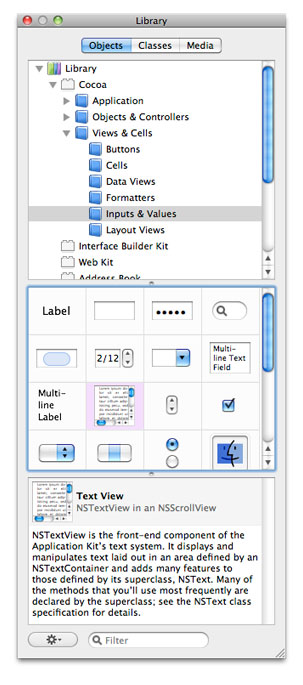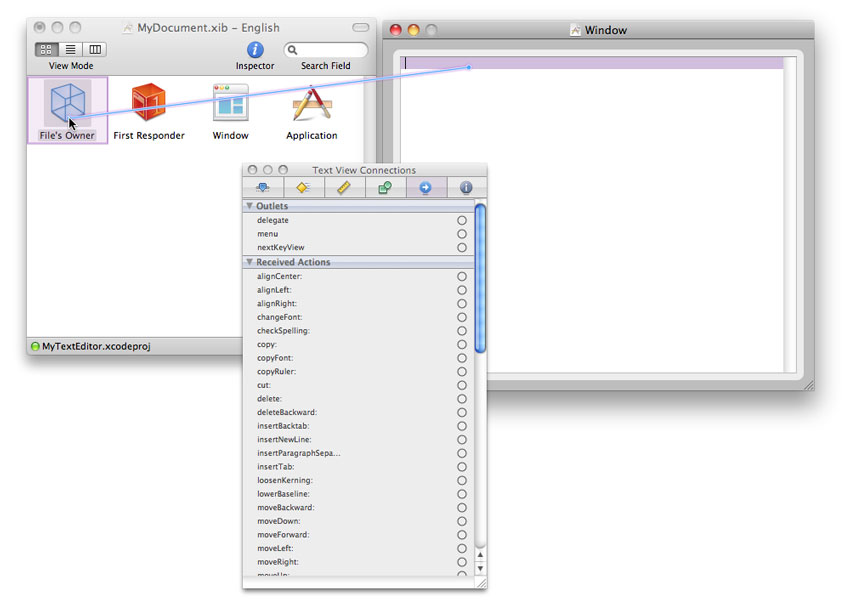Building a Text Editor in 15 Minutes
This article shows how you can use Cocoa to create a simple but highly capable text editor in less than 15 minutes using Xcode and Interface Builder. The Cocoa document architecture provides many of the features required for this type of application automatically, requiring you to write a minimal amount of code.
This tutorial uses Xcode version 3.2 and Interface Builder version 3.2 with Mac OS X version 10.6.
Here is a simplified summary of the steps needed to complete this task:
Use Xcode to create a new document-based application.
Use Interface Builder to add an
NSTextViewobject to the application’s window.Add some code to the document’s controller class.
Connect the user interface to the code.
You can build and test the application at several stages of completion. The following steps expand and explain this procedure. The steps assume that you have a basic acquaintance with Xcode and Interface Builder.
Create the User Interface
This section shows how to use Xcode and Interface Builder to create the project and build its user interface.
In Xcode, create a new project. Choose the Mac OS X template for a Cocoa application, and select the document-based application option.
Open the
MyDocument.xibfile, in the Resources folder in the Groups & Files pane of the Xcode window, by double-clicking theMyDocument.xibicon, which launches Interface Builder.MyDocument.xibis the nib file containing the user interface for yourNSDocumentsubclass, namedMyDocumentby the document-based application template.In the Window object, click the text field “Your document contents here” once and press the Delete key to delete the text field. (If you click twice, you begin editing its text content.) If the Library window is not already showing, choose Tools > Library. Click the Objects tab and navigate to Views & Cells > Inputs & Values.
Select a text view as shown in Figure 1. Drag the text view onto the Window object. Resize the text view to almost fill the window, leaving margins as indicated by Interface Builder’s guide lines (which appear when the margins are correct).
Click in the center of the view area and choose Tools > Size Inspector to open the inspector window. Ensure that the inspector window title reads “Scroll View Size.” Set the view to resize with the window by clicking both inner sets of crossed arrows in the Autosizing area, as shown in Figure 2. The inspector animation should indicate that the scroll view resizes with the window in both vertical and horizontal directions.
Select the text view by clicking near the top of the view area. Choose Tools > Attributes Inspector (or click the Attributes tab of the inspector window), and ensure that the inspector window title reads “Text View Attributes.” Ensure that the Selection pop-up menu is set to Character and the Text Direction pop-up menu is set to Natural. Ensure that the following (default) options are selected: Editable, Selectable, Rich Text, Undo, Non-contiguous Layout, Draws Background, Find Panel, Font Panel, Ruler, Continuous Spell Checking, Smart Insert and Delete, and Autoresizes Subviews.
Choose File > Simulate Interface, and resize the window to ensure that the text view resizes properly along with the window. Note that you can already edit text in the text view. When you drag the Text View object from the Library, Interface Builder automatically instantiates all the Cocoa text objects required for a complete editing and layout implementation. Choose Cocoa Simulator > Quit Cocoa Simulator to return to Interface Builder.
Save the
MyDocument.xibfile and return to Xcode. Build and test the new application.
At this stage of your editor’s development, it has many sophisticated features. You can enter text, which you can then edit, cut, copy, and paste. You can find and replace text using the Find window. You can undo and redo editing actions. You can also format text, setting its font, size, style, and color attributes. You can control text alignment, justification, baseline position, kerning, and ligatures. You can display a ruler that provides a graphical interface to manipulate many text and layout attributes, as well as setting tab stops. You can even use the spelling checker.
In addition to its many editing features, your editor can open multiple documents, each with its own text view and contents. What it lacks most prominently are the abilities to open files and save text in files (that is, archiving and unarchiving documents). It also lacks such features as displaying its own icon in the Finder and presenting useful information in the About window.
Quit your new application before proceeding to the next section.
Implement Document Reading and Writing
This section explains how to enable your editor to open and save documents in files.
Add an instance variable for the text view, so you can connect the text view with the code in your
NSDocumentsubclass that handles archiving and unarchiving of documents in files. You also need to add an instance variable to hold the text string being edited (the document’s data model). In Xcode, put the variable declarations inMyDocument.has follows:#import <Cocoa/Cocoa.h>
@interface MyDocument: NSDocument
{IBOutlet NSTextView *textView;
NSAttributedString *mString;
}
@end
Initialize the string instance variable. Put the following lines in the
initmethod (which has a stub implementation) inMyDocument.m:if (mString == nil) {mString = [[NSAttributedString alloc] initWithString:@""];
}
Write getter and setter methods for the string instance variable. Put them in
MyDocument.mas follows:- (NSAttributedString *) string { return [[mString retain] autorelease]; }- (void) setString: (NSAttributedString *) newValue {if (mString != newValue) {if (mString) [mString release];
mString = [newValue copy];
}
}
Add method declarations for the getter and setter methods, so that the header file
MyDocument.hlooks like this:#import <Cocoa/Cocoa.h>
@interface MyDocument: NSDocument
{IBOutlet NSTextView *textView;
NSAttributedString *mString;
}
- (NSAttributedString *) string;
- (void) setString: (NSAttributedString *) value;
@end
If it is not already open, double-click
MyDocument.xibto open the document window in Interface Builder. From Xcode, drag theMyDocument.hfile icon onto the document window ofMyDocument.xib. This step informs theMyDocument.xibfile that theMyDocumentobject interface now has an outlet variable namedtextView.In the document window of Interface Builder, double-click the Window icon to open the Window object. Open the inspector. In the Window object, click inside the view area at the top to select the text view object. Be sure you select the text view object and not its containing scroll view object, as indicated by the title of the inspector window.
Connect the
textViewoutlet of the File's Owner (that is, theMyDocumentobject) by Control-dragging from the File's Owner icon in the document window ofMyDocument.xibto the text view, which is selected in the window, as shown in Figure 3. When the connection is made, Interface Builder displays a list of prospective outlets under the mouse pointer. Click thetextViewoutlet. (Alternatively, you can select the File’s Owner icon in the document window and use the Connections tab of the inspector to make the connection by dragging from the circle opposite thetextViewoutlet to the text view selected in the Window object.)In Interface Builder, make the File’s Owner (that is, the
MyDocumentobject) the delegate of the text view. Select the text view in the Window object and Control-drag from the text view to the File’s Owner icon, as shown in Figure 4. When the connection is made, Interface Builder displays the text view’s outlets under the mouse pointer. Click the delegate outlet. (Alternatively, you can select the text view in the Window object and use the Connections tab of the Inspector to make the connection by dragging from the circle opposite thedelegateoutlet to the File’s Owner icon, which is selected in the document window.)Implement the text view’s delegate method
textDidChange:inMyDocument.mto synchronize the text string in the document’s data model (themStringinstance variable) with the text storage belonging to the text view, whenever the user changes the text.- (void) textDidChange: (NSNotification *) notification
{[self setString: [textView textStorage]];
}
Implement document reading and writing methods. When you initially created the project, Xcode placed stubs for these methods in
MyDocument.m. Fill in the method bodies as follows:- (BOOL)readFromData:(NSData *)data ofType:(NSString *)typeName error:(NSError **)outError
{BOOL readSuccess = NO;
NSAttributedString *fileContents = [[NSAttributedString alloc]
initWithData:data options:NULL documentAttributes:NULL
error:outError];
if (fileContents) {readSuccess = YES;
[self setString:fileContents];
[fileContents release];
}
return readSuccess;
}
- (NSData *)dataOfType:(NSString *)typeName error:(NSError **)outError
{NSData *data;
[self setString:[textView textStorage]];
NSMutableDictionary *dict = [NSDictionary dictionaryWithObject:NSRTFTextDocumentType
forKey:NSDocumentTypeDocumentAttribute];
[textView breakUndoCoalescing];
data = [[self string] dataFromRange:NSMakeRange(0, [[self string] length])
documentAttributes:dict error:outError];
return data;
}
Add three lines of code to the
windowControllerDidLoadNib:method to place the contents of the window’s data model into the text view when the window’s nib file is initially loaded. Leave the call to the superclasswindowControllerDidLoadNib:method and add the following lines after it:if ([self string] != nil) {[[textView textStorage] setAttributedString: [self string]];
}
Build and test your application.
Your editor should now be able to save documents that you create to files, and it should be able to open those documents again and continue editing them. If you attempt to close a document that has been changed since it was last saved, the editor should display a warning dialog and let you save the document.
At this stage of its development, your editor opens and saves documents only with an extension of ????. To enable your application to save and open documents with a recognized file type, you need to use Xcode to configure the document types settings in the application’s property list file in the Resources folder in Xcode. (The Xcode template names the file with your project name followed by -Info.plist.) You can edit this file in Xcode by selecting the file in the Groups & Files list and using the built-in editor. Click the disclosure triangles to edit the value of the first item under CFBundleTypeExtensions to the preferred extension for your document files.
For more information about property list files, see “Storing Document Types Information in the Application's Property List” in Document-Based Applications Overview. For complete details about application property lists, see Runtime Configuration Guidelines.
You can also specify your application’s icon file in the application’s Info.plist file. You can add useful information to be displayed in the About box by editing the Credits.rtf file in the Resources folder in Xcode.
For more examples of Cocoa text applications, refer to the Sample Code resource type of the Mac OS X Reference Library. You can find text-related examples in the Data Management and User Experience topics.
Last updated: 2009-11-30



